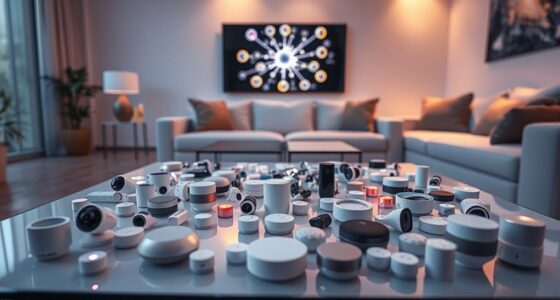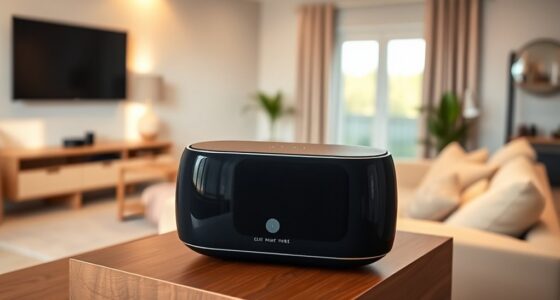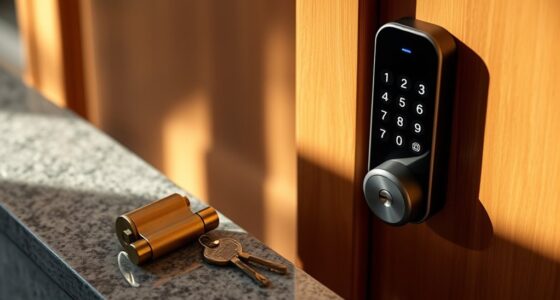To use geofencing for smart home automation, start by setting virtual boundaries around your property in your smart home app. When your smartphone crosses these boundaries, the system automatically triggers actions like turning on lights or adjusting the thermostat. Fine-tune the geofence radius for better accuracy and guarantee your privacy is protected by reviewing app permissions. Understanding these steps helps you create a seamless home experience; keep exploring to discover how to optimize your setup further.
Key Takeaways
- Define your property boundaries and set up geofences within your smart home app for accurate triggers.
- Link specific device actions, like lights or thermostats, to geofence crossing events.
- Adjust the geofence radius to minimize false triggers and improve automation accuracy.
- Review privacy settings and limit location sharing to protect personal data and prevent unauthorized access.
- Regularly test and fine-tune your geofencing setup to ensure seamless and secure home automation.

Imagine arriving home and having your smart lights turn on, your thermostat adjust to a comfortable temperature, and your security system disarm—all automatically as you approach. This seamless experience is made possible through geofencing, a technology that uses your smartphone’s location triggers to activate your smart home devices when you near your residence. To set this up, you’ll need to define specific boundaries around your property in your smart home app. When your phone crosses these virtual fences, the system recognizes your presence and triggers the pre-set actions. It’s a convenient way to enhance comfort and security, but it does come with some privacy concerns you should consider.
Location triggers rely on GPS or Wi-Fi signals to determine your proximity to home. When configured properly, they allow your devices to respond instantly, ensuring you never have to manually turn on the lights or adjust the thermostat. However, because these triggers depend on continuous location tracking, they raise questions about your privacy. Some users worry about how their location data is stored and whether it could be accessed by third parties or used for targeted advertising. It’s important to review your app’s privacy policies and choose reputable providers that prioritize data security. You might also want to customize your settings to limit how often your location is shared or to disable tracking when you’re not actively using the system.
Location tracking enables instant device responses but raises privacy concerns; review policies and customize settings to protect your data.
Another privacy concern involves the potential for false triggers or unauthorized access. If your geofencing setup isn’t precise, it might activate when you’re nearby but not actually home, or it could be triggered by someone else’s device if it’s within the boundary. To minimize this, you can fine-tune the geofence radius to suit your routine, ensuring that only your device’s location triggers the automation. Additionally, securing your smart home network with strong passwords and two-factor authentication helps prevent unauthorized access that could compromise your privacy or disrupt your system. Understanding how high-quality projectors work and their features can also help you optimize your home automation setup for entertainment.
Ultimately, using geofencing for smart home automation offers incredible convenience, but it also demands careful attention to privacy. You should weigh the benefits of effortless automation against the potential risks of sharing your location data. By understanding how location triggers work and taking steps to protect your information, you can enjoy a smarter, safer home that responds precisely to your presence. Remember, staying informed and vigilant keeps your privacy intact while maximizing the advantages of geofencing technology.
Frequently Asked Questions
Can Geofencing Work Without an Internet Connection?
Geofencing typically relies on GPS dependency, so it usually needs an internet connection for accurate location tracking. Without internet access, offline functionality becomes limited, and your device may not update your location properly. This means geofencing won’t work reliably if you’re offline, as it depends on real-time GPS data and cloud services. To guarantee smooth automation, keep your internet connection active, especially when you’re relying on geofencing features.
How Accurate Is Location Detection in Geofencing Systems?
Think of GPS accuracy as a weather vane, swaying with signal interference like gusts of wind. Your location detection in geofencing systems is generally precise, often within a few meters, but can be thrown off by tall buildings, dense trees, or bad signal interference. While technology has improved, it’s not perfect—so expect occasional hiccups, especially in challenging environments, but for most smart home needs, it’s accurate enough to keep things running smoothly.
What Privacy Concerns Are Associated With Geofencing?
When considering privacy concerns with geofencing, you’re right to worry about data privacy and location tracking. As your device constantly monitors your whereabouts, it can share sensitive information with third parties or be vulnerable to hacking. You should review app permissions carefully, disable location services when not needed, and choose systems with strong security measures. Staying informed helps protect your privacy while enjoying the benefits of geofencing technology.
How Do I Set up Multiple Geofences for Different Zones?
To set up multiple geofences for different zones, you need a smart home app that supports multi zone configuration and geofence segmentation. Start by dividing your property into distinct zones within the app, then define the specific boundaries for each geofence. Assign automation rules to each zone, like turning lights on or off. This way, your smart home responds accurately to your location in multiple areas.
Is There a Risk of False Triggers With Geofencing?
Did you know that false positives in geofencing can occur in up to 10% of cases? Yes, there’s a risk of false triggers, which can affect trigger reliability. You might find your devices responding unexpectedly if GPS signals falter or if your boundary settings aren’t precise. To minimize this, make sure your geofences are accurately configured and keep device software updated for better accuracy and fewer false positives.
Conclusion
With geofencing, your smart home becomes an unstoppable fortress of convenience, responding instantly to your every move. It’s like having a personal butler who anticipates your needs before you even think of them. Once you set it up, your home practically reads your mind—no more fumbling for keys or wasting energy. Embrace geofencing, and watch your house transform into the smartest, most effortless haven you’ll ever live in. It’s truly a game-changer!









